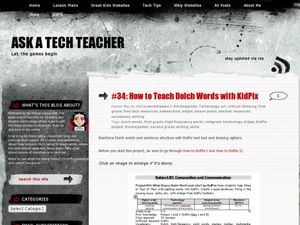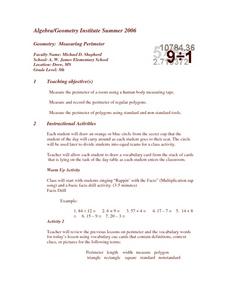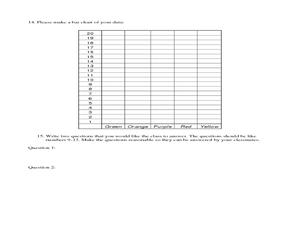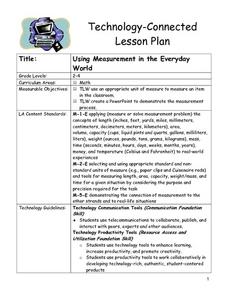Curated OER
How to Teach Dolch Words with Kid Pix
Students use KidPix computer program to learn Dolch sight words. In this technology and language lesson, students type their Dolch sight words into KidPix to create a quasi-sentence.
Curated OER
Bridging Communication
Learners investigate how to create drawings using a word processing program. They examine the use of draw tools in Microsoft Word. They combine drawing with the patterns they made for a truss bridge projects. They follow the teacher's...
Curated OER
Business Cards
Students follow step-by-step instructions to create a business card. They experiment with a variety of fonts and word processing features to create a business card and then design and produce an original business card.
Curated OER
It's Not All Greek to Me
Learners find out the meaning for prefixes used in math vocabulary. By dissecting words used in everyday math, they figure out what the prefix indicates and what the word means. A variety of well-organized worksheets and activities...
Curated OER
Animal Research Paragraph
Students investigate animals. In this animal research lesson, students choose an animal to research online and record facts from at least 3 types of resources. Students complete a webbing tool, write a paragraph, and use MS word or...
Curated OER
Measuring Perimeter
Have your class practice measuring the perimeter of various objects using this resource. Fifth graders place various-sized polygons in order (from largest to smallest). They use non-standard measuring tools to estimate the distance...
Curated OER
Using Ratios to Taste the Rainbow
Students solve problems using ratios and proportion. In this algebra lesson, students analyze skittles and their different colors as they apply the properties of ratios and proportions to solve their problems.
Curated OER
Don't Settle for a Byte... Get the Megabyte on Technology
Students use word processing, presentation, and spreadsheet software. In this multi-day computer software usage instructional activity, students complete a research project that requires the use of a word processor, Excel, FrontPage, and...
Curated OER
A Visit to China
Sixth graders study the history of China. They explore the Chinese people, the Great Wall of China, religions, government and Dynasties. In groups, 6th graders collect information on China. They write a report on their findings and...
Curated OER
Designing a Robot and Microsoft PowerPoints
Ninth graders discover the uses and main characteristics of robots then design a robot that performs a task that people do not want to do. Colored drawings of their robot are created including labels of the parts and explanations of...
Curated OER
Bon Voyage: Travel and Exploration
Students use the internet and other media to locate and collect information about travel. They interpret the information they collect and convert American currency to foreign currency. Students create scale drawings of travel cards.
Curated OER
New York State Testing Program: Mathematics Book 3, Grade 4
For this 4th grade math standardized test practice worksheet, students solve 6 multiple-step open-ended math problems based on New York academic standards.
Curated OER
Prime and Composite Numbers
Fifth graders use prime factorization to identify prime and composite numbers. They use cubes to find factors. In groups, 5th graders draw rectangular arrays to discover prime numbers under 100.
Curated OER
Perimeter
Fifth graders create math word problems. In this geometry activity, 5th graders define perimeter and discover how to find the perimeter of a rectangle, a square and a regular polygon. Students write word problems on finding the...
Curated OER
The Island of The Blue Eagles
Sixth graders read the book CALL IT COURAGE by Armstrong Sperry. They use the Internet to research and work in groups to write ocean chants. They construct dioramas and build a sea turtle withK'NEX.
Curated OER
Polydron Fun
Students investigate nets as they relate to volume and area. In this geometry lesson, students use nets as a visual to deepen their understanding of surface area and volume of objects. They make conjectures about different objects and...
LABScI
Catapult: Flight of the Marshmallows
Watch your marshmallows fly. The engaging STEM activity has groups create a catapult to launch marshmallows. After testing their prototypes, they consider improvements and redesign their catapults.
Curated OER
Mother's Day Flowers
Students complete a circle map describing why they love their mom and use a flower template to type the ways. Then they insert a digital picture into the center of the flower. The flowers are then printed out and given to their mothers...
Curated OER
Data! Data! Graph that Data!
Fifth graders create data graphs using Microsoft Excel. In this data collection instructional activity, 5th graders create and conduct a survey, then use Excel to organize and graph their data.
Curated OER
Using Measurement in the Everyday World
Students use an appropriate unit of measure to measure an item in the classroom. They create a PowerPoint to demonstrate the measurement process. Pupils are divided into pairs. Students use a concept map to discuss the terms for...
Curated OER
Candy Land Math
Students order numbers and sets of objects from 0 through 10 and organize and interpret information collected from the immediate environment. They read and interpret graphs usin real objects and the computer. Finally, students sort a...






















